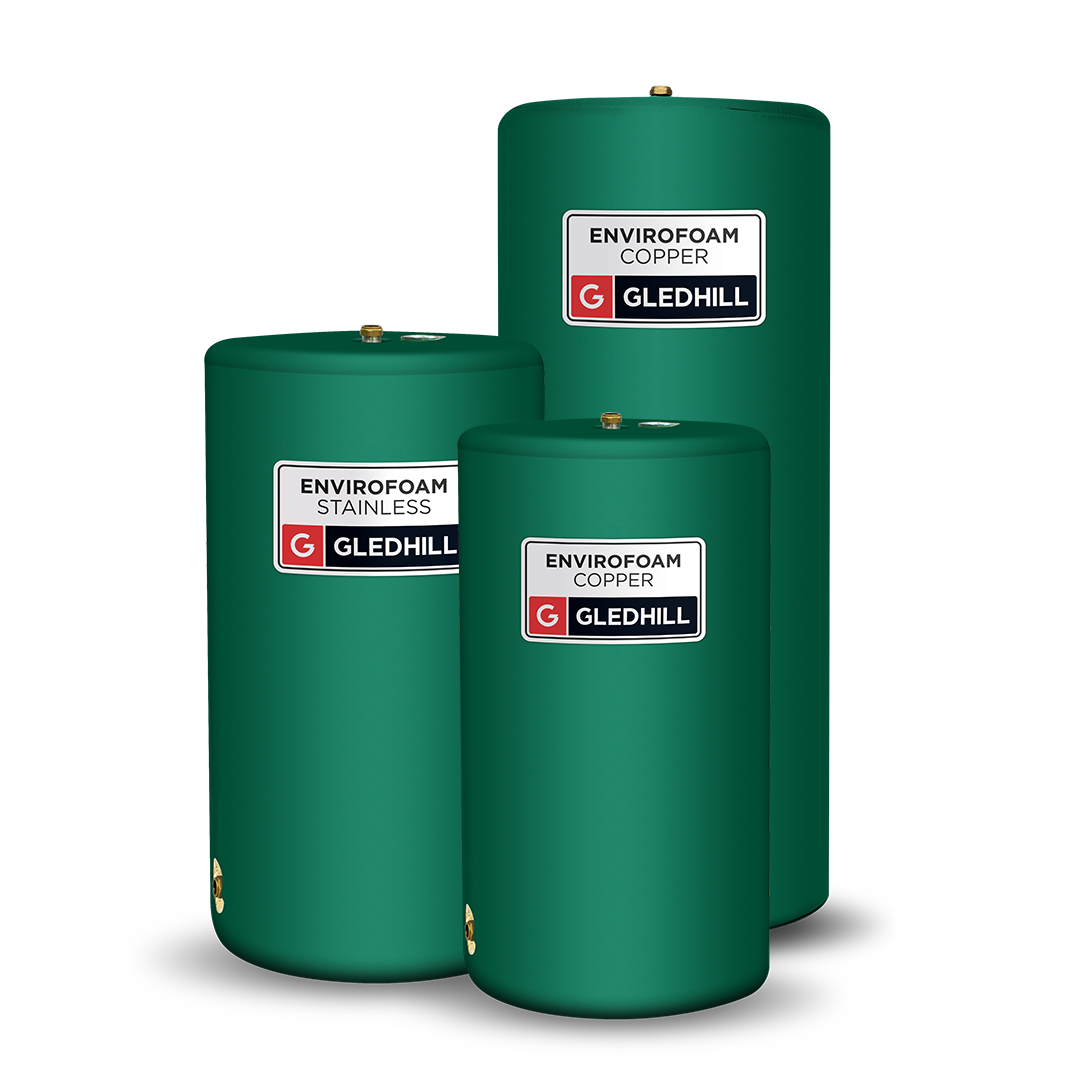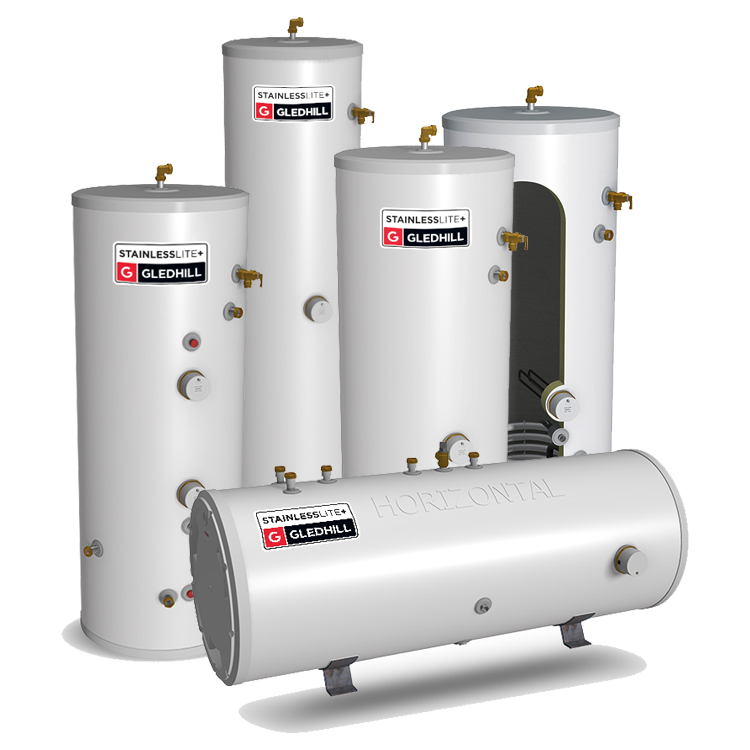Following the continued advancement and innovation in water heating throughout the years, there are a wide range of hot water systems available today, which can make it difficult to determine which heating system is the best option for your home. Debbie Healey, Product Manager at Gledhill Building Products Ltd, takes a look at vented and unvented cylinders to assess which is better.
There are essentially two types of hot water cylinders that we need to be aware of: vented and unvented. Each of these cylinders supplies hot water to the property, however, they both do this in very different ways and the ways in which they do this determines the choice you make for your home.
Vented Cylinders
Vented cylinders are known as the traditional option, as they have been around for decades and were first manufactured using copper due to the material’s efficient conductivity of heat. Now available in both copper and stainless steel, vented cylinders store and heat water that is fed directly from a tank in the loft. As the tank in the loft is situated in a location higher than the vented cylinder, this provides a natural gravitational force of water to the system, enabling it to provide a flow of hot water to the tap outlets throughout the property.
One of the benefits of a vented cylinder is due to the water tank in the loft being a constant source of water with a consistent gravitational force, the cylinder is able to provide hot water to numerous bathrooms with a consistent head of pressure. However, the necessity of the water tank can place a restriction on where the vented cylinder is installed within the home and its dependency on the gravitational pull from the tank can have a negative impact on the pressure flow of water should there not be enough height between the tank and the tap outlets. For example, the pressure of water to the upstairs taps could be weaker than the pressure to the outlets located downstairs.
It’s important to note however, that a vented cylinder requires virtually no maintenance and is a simpler system to install, ultimately making it the cheaper choice. Due to vented cylinders having been around since the first inception of hot water systems, they are the most common cylinder found within properties across the UK, meaning that a ‘like for like’ replacement is the simplest selection rather than suffering a higher cost for an upgrade to an unvented system.
Unvented Cylinders
An unvented hot water cylinder differs in that it provides mains pressure hot water directly from the cold mains as opposed to tank pressure water provided with a vented cylinder. The cold water is directly pulled from the main water supply and is then heated by the selected heat source relevant to the cylinder type. For example, a direct unvented cylinder utilises electricity to heat the water using immersion heaters, whilst an indirect unvented cylinder utilises gas from a boiler to heat the water.
As the mains pressure hot water provided by an unvented system is fed directly from the cold mains, it provides a better pressure performance than a vented cylinder. However, because an unvented cylinder is a ‘sealed’ system it requires an expansion vessel to hold the excess volume of heated water when it expands within the cylinder. This means that a G3 qualified specialist is needed to install the cylinder and it must undergo regular maintenance to meet safety regulations. This can result in a more expensive selection compared to the simple and low maintenance of a vented cylinder.

One of the core benefits to point out with an unvented cylinder is the flexibility it provides when there are space restrictions in the property, as there is no requirement for a cistern tank. This means that the cylinder itself can be installed in the loft – out of sight and out of mind. Further to this, Gledhill provide an unvented horizontal cylinder and a slimline unvented cylinder within its StainlessLite Plus range, which enables the cylinder to be installed in tight spaces such as airing cupboards.
Which is better?
Well, it ultimately comes down to what is most important to you. Is it your budget, space, maintenance costs or could it even be the warranty and support that concerns you most?
If you need to keep to a specific budget then it’s probably best to purchase a vented cylinder, particularly if you’re looking for a replacement. They’re cheaper to maintain and will cost you less to install. Gledhill’s EnviroFoam range comes with 35mm pouring foam insulation to provide exceptionally low standing heat loss for a more cost-efficient product, whilst also offering a 10-year warranty.
If you’re worried about space then it has to be an unvented system, particularly with slimline and horizontal options being available. Gledhill’s StainlessLite Plus range can be installed almost anywhere in the property, such as the loft and tight airing cupboards, whilst also providing mains pressure performance throughout the home. Offering a 25-year warranty with on-site technical support, Gledhill’s flagship unvented range also offers peace of mind.
Key points to remember
Vented:
- Pros:
- Cheaper to install and maintain
- ‘like for like’ replacement
- Consistent water pressure and supply when mains pressure is low due to high demand
- Cons:
- Dependent on a water tank in the loft
- Relies on gravitational pull of water for pressure flow to outlets
Unvented:
- Pros:
- Solution to space restrictions – can be installed almost anywhere in the property
- No need for water tank
- Provides mains pressure hot water for better flow rates
- Cons:
- More expensive to install – requires a G3 specialist
- Requires annual maintenance to meet safety regulations
Regardless of which cylinder choice you make, Gledhill offer an extensive range of both vented and unvented hot water cylinders. If you’re still not sure what you’re looking for our technical support team have first-hand experience of working with cylinders for over 30 years and can help you source the cylinder you need – just call them on 08000 427 427.
Gledhill are dedicated to providing durable, efficient products which meet the needs of our customers.
For more information on our products, please click here.
